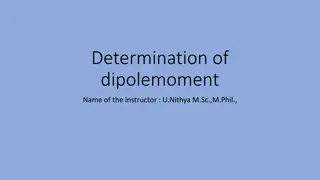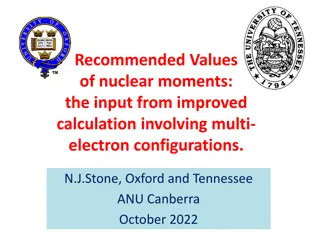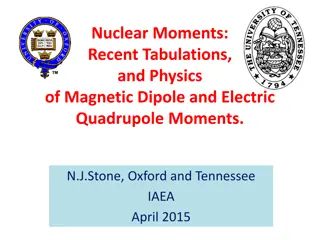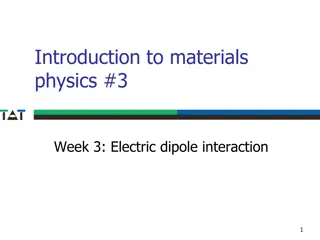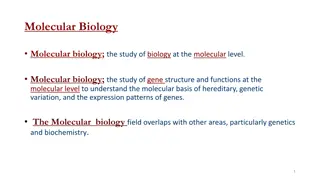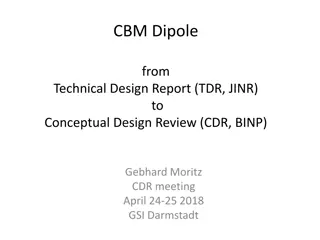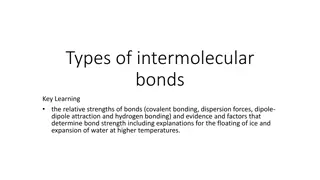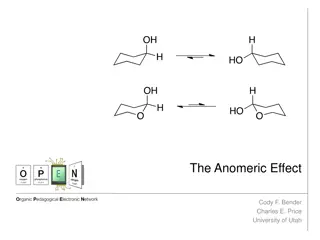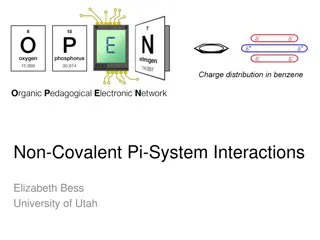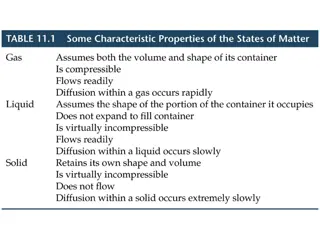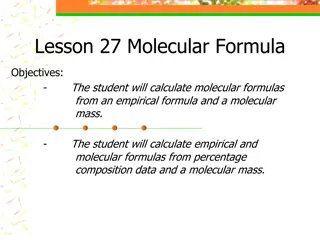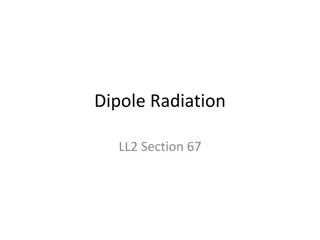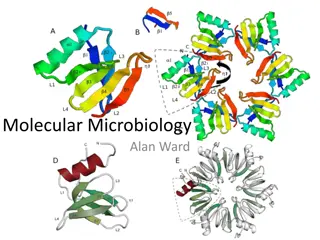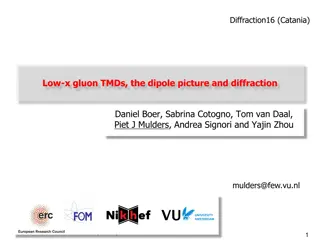Dipole Moments in Molecular Structure
Dipole moments play a crucial role in understanding the polarity of molecules. They are defined as the product of charges and the distance between these charges, providing insight into charge separation within a molecule. Differences in electronegativity of bonded atoms influence the magnitude of dipole moments, with higher values indicating greater polarity. This concept is illustrated through examples such as CH3Cl and diatomic molecules like Cl2 and KBr. Furthermore, for polyatomic molecules, the total molecular dipole moment is a vector sum of individual bond dipole moments, aiding in the estimation of overall molecular polarity.
Download Presentation

Please find below an Image/Link to download the presentation.
The content on the website is provided AS IS for your information and personal use only. It may not be sold, licensed, or shared on other websites without obtaining consent from the author.If you encounter any issues during the download, it is possible that the publisher has removed the file from their server.
You are allowed to download the files provided on this website for personal or commercial use, subject to the condition that they are used lawfully. All files are the property of their respective owners.
The content on the website is provided AS IS for your information and personal use only. It may not be sold, licensed, or shared on other websites without obtaining consent from the author.
E N D
Presentation Transcript
Factors affecting the rate of a Chemical reaction Concentration and the rate law Definition of rate law How to determine rate law from given experimental data Rate Constant Units of rate constant 2
1. Temperature 2. Concentration of Reactants 3. Pressure in case of gaseous reactants 4. Surface area 5. Orientation (molecules must collide in a specific manner to form a chemical bond) 6. Nature of the reactant 7. catalyst 3
Concentration more reactants will often increase the rate of reaction. This occurs because a higher concentration of a reactant will lead to more collisions of that reactant in a specific time period. Temperature reaction rates because of the disproportionately large increase in the number of high energy collisions. It is only these collisions (possessing at least the activation energy for the reaction) which result in a reaction. Pressure reacting gases increases the rate of reaction. If there are more molecules in a smaller volume, the chances of collision are greater, and the rate increases. The volume of solids and liquids does not change with pressure. Concentration : Increasing the concentration of one or Temperature Increasing the temperature increases Pressure: Increasing the pressure on a reaction involving 4
Surface area: The rate of a chemical reaction can be raised by increasing the surface area of a solid reactant. More particles are exposed to the other reactant. There are more collisions. Orientation: The orientation of the colliding molecules partially determines whether a reaction between the two molecules will occur or not. Nature of the reactant: Solid reactions are slow, reactions of liquids are fast whereas that of gases are very fast. Catalyst: A catalyst is a substance that accelerates a reaction by participating in it without being consumed. Catalysts provide an alternate reaction pathway to obtain products. 5
Increasing the concentration of one or more reactants will often increase the rate of reaction. This occurs because a higher concentration of a reactant will lead to more collisions of that reactant in a specific time period. The representation of rate of reaction in terms of concentration of the reactants is known as rate rate law law. 6
Let us consider a hypothetical reaction, A + B C Rate of reaction molar concentration of A Rate of reaction molar concentration of B Rate [A]x Rate [B]y Rate = k [A]x [B]y Rate law for the reaction Where k is proportionality constant called ate constant 7
Rate rate concentration of reactants with each term raised to some power, which may or may not coefficient of the reacting species in a balanced chemical equation. Rate la law w is the expression in which reaction is given in terms of molar be same as the stoichiometric Rate law for any reaction cannot be predicted by merely looking at the balanced chemical equation, i.e., theoretically but must must be be determined determined experimentally experimentally 8
REACTION REACTION RATE Rate = k[NO]2[02] RATE LAW LAW 2NO(g) +02(g) 2N02(g) 2NO(g) + 2H2(g) 2N2(g) 2H2O(g) 2ICI(g) + H2(g) 2HCI(g) + I2(g) Rate = k[NO]2[H2] Rate = k[ICI]2[H2] Rate = k[N2O5] 2N205(g) 4NO2(g) + O2(g) Rate = k[NO2][F2] 2NO2(g) + F2(g) 2NO2F(g) Rate = k[H2O2] 2H2O2(aq) 2H2O(l) + 02(g) Rate = k[H2][Br2] H2(g) + Br2(g) 2HBr(g) Rate = k[O3][CI] 03(g) + CI(g) 02(g) + CIO(g) 9
Using the given data, determine the rate law of this reaction. Using the given data, determine the rate law of this reaction. A + 2B A + 2B -- --> C + D > C + D Trial A (M) B (M) RATE (M/s) 0.310 0.310 0.620 0.340 0.680 0.340 0.0213 0.0213 0.0852 1 . 2 . 3 . 10
image 11
The rate constant is defined as the proportionality constant which explains the relationship between the molar concentration of the reactants and the rate of a chemical reaction. Characteristics of rate constant: 1. Rate constant is a measure of the rate of reaction. Greater is the value of the rate constant, faster is the reaction. 2. Each reaction has a definite value of the rate constant at a particular temperature. 3. The value of the rate constant for the same reaction changes with temperature. 4. The value of the rate constant of a reaction does not depend upon the concentrations of the reactants. 5. The units of the rate constant depend upon the order of reaction. Characteristics of rate constant: 12
(i) The unit of second order rate constant is L mol 1 s 1, therefore k = 2.3 10 5 L mol 1 s 1 represents a second order reaction. (ii) The unit of a first order rate constant is s 1 therefore k = 3 10 4 s 1 represents a first order reaction. 14




